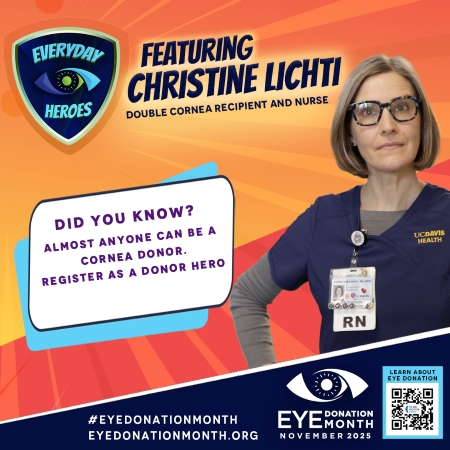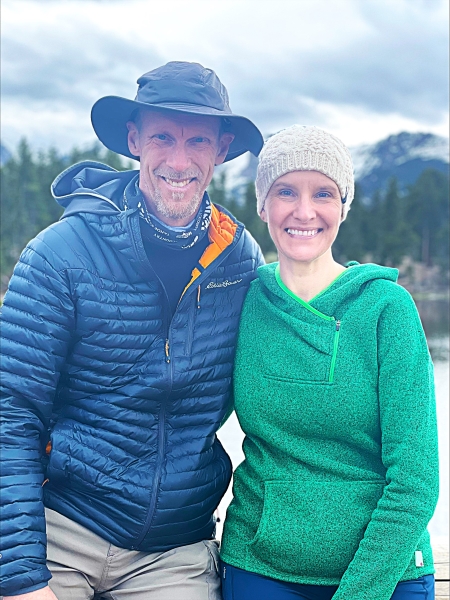November is Eye Donation Month, a time to raise awareness about the life-changing impact of cornea donation. It's also a time to honor the "Everyday Heroes" — donors and their families — who make the gift of sight possible.
This year, the Eye Bank Association of America is featuring the journey of UC Davis Health's very own Christine Lichti in its national campaign to encourage cornea donation.
Lichti is a 25-year pediatric critical care nurse who received corneal transplants in both eyes.
Her life and career were profoundly affected by corneal disease.
"My main issue was severe light sensitivity that affected my ability to drive safely, especially first thing in the morning or at night," Lichti shared. Any bright light would cause pain and profuse tearing.

"Thanks to my donor," Lichti added "I can now drive to work safely, enjoy a sunny day in the snow or at the lake, and even watch fireworks — all things I couldn't do before."
Lichti's journey with cornea donation is also deeply personal.
"As an ICU nurse, I've taken care of patients who became organ donors, and I've cared for those who received transplants. Now, I've been on the other side, as a recipient of this incredible gift."
"To my donor and their family, thank you for your tremendous and selfless gift. I try to live my life to honor your gift to me," Lichti said.
What is corneal transplantation?
The cornea is the clear, dome-shaped surface at the front of the eye that helps focus light and enables vision.
When the cornea becomes cloudy or scarred due to disease, inflammation or injury, it can lead to significant vision loss or blindness.
With corneal transplantation, a surgeon replaces the damaged or diseased cornea with a healthy cornea from a deceased donor. The surgery is usually done on an outpatient basis, with patients able to go home the same day.
Corneal transplantation restores vision
Jennifer Li, a corneal surgeon in the Department of Ophthalmology and Vision Science at UC Davis Health, performed Lichti's surgery.
Li emphasized the importance of donors in making these surgeries possible. "I can't do my job without donors. That's the reality. What I love about my job is helping people see again. We couldn't do it without donors and donor families," Li said.
Globally, an estimated 12 million people have corneal blindness that could be treated with a transplant from a donor.
What I love about my job is helping people see again. We couldn't do it without donors and donor families.-Jennifer Li, professor and corneal surgeon, Department of Ophthalmology and Vision Science
"Corneal transplantation gives us the opportunity to restore function, quality of life and the ability to interact with the world," Li said. "I never want my patients to feel like they can't continue to do the things that give them joy."
Eye Donation Month, every November, is a time to recognize the heroes who make these miracles possible.
"Everyone can be a hero through donation," Lichti said. "By becoming a donor, you're leaving the ultimate legacy."
UC Davis has 50-year history with the local donor eye bank
Sierra Donor Services Eye Bank, a local nonprofit that serves the Sacramento region, provided the corneas for Lichti's surgery. The UC Davis Department of Ophthalmology helped launch the eye bank in 1975.

George O. Waring III, an ophthalmologist, led the charge to recover and transplant corneal tissue. Just a few years later, Mark J. Mannis, ophthalmologist and recently retired chair of the department, expanded the mission by guiding the eye bank into broader tissue banking and national recognition. Their foresight laid the foundation for decades of restored sight across Northern California and Nevada. See more about the history here.







